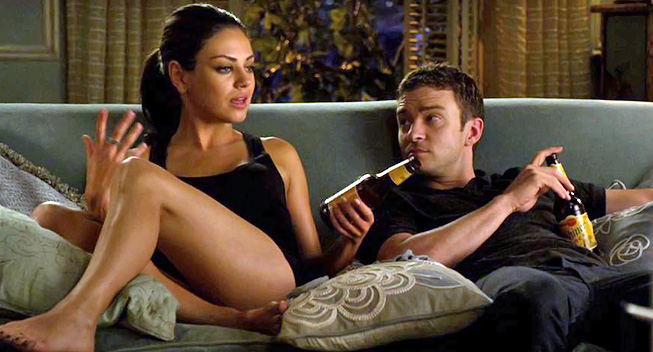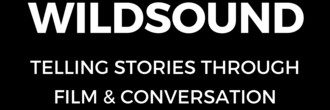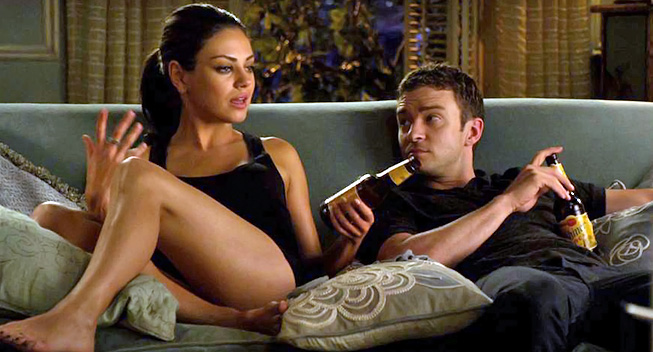Chatting with Tia Nolan about the craft of editing was a pure joy. Her recent credits include: How to be Single (2016), Angie Tribeca season 2 (2016), Annie (2014), Friends with Benefits (2011), The Woman (2008), and Bewitched (2005). She is a wealth of knowledge in the art of making a great comedy – as you’ll learn in his interview. Enjoy!
Matthew Toffolo: What is the role of a TV episode editor? How is this different is comparison to working on a feature film?
Tia Nolan: The role of a TV episode editor is to assemble and fine tune the footage provided to its final broadcast ready product. I have only worked in scripted half hour comedy television. I have found that the craft is similar to feature film editing in performance and timing. The real difference lies in the schedule and who gets final cut. In television, there are usually two or three editors on the show. This means that every two or three weeks, you get a new episode to cut, even if you haven’t finished the previous episode. The schedule is very fast paced. You only spend 2 days with a director and there are usually different directors for each episode. Your real cutting room relationships are with the producers of the show. You can find yourself doing notes on multiple episodes in the same day with the producers.
In features, I am involved in every aspect of the process from dailies to final mix and color timing. In television, the AP runs the mix and color timing for each episode because the editors are needed to continue editing the episodes. In features, I get to spend more time with the director and producers finding the characters, the story and the comedy. There isn’t that luxury of time in television. That said, the shows are shorter so you don’t need as much time to massage the material. But you also have to cut each episode to a specific time, which can be maddening if you have to kill off great material to get to that time. I actually enjoy being able to go between both mediums. It keeps me on my toes.
PHOTO: Rashida Jones stars in “Angie Tribeca” TV show:

MT: What film that you’ve worked on has been your most valuable experience?
TN: That’s a hard question to answer. As an overall answer, I’d say any film I worked on with Richard Marks, my mentor, because he really taught me how to look at a film and make it great. If I were to pick one film that was the most valuable, I’d say FRIENDS WITH BENEFITS.
I had only been cutting on my own for a short while when I got this job. The nature of comedy was changing and what I had learned from my years of working with Richard Marks, James L. Brooks and Nora Ephron was not what the world was craving anymore. When I started working with Will Gluck, he really pushed me to change the pace of my cutting. He wanted his actors to deliver lines fast and punchy like the old screwball comedies, but he wanted them to feel like real people as well.
Though he cowrites all of his films, he loves to go off book and throw ad libs to his actors. He rarely calls cut. FWB was the first digital film I had worked on. I found myself with 30 min. long takes.
But I watched every frame. And in doing so, I was able to listen to his direction to the actors and understand what he was going for. Will Gluck also insists on seeing a rough cut with sound design and music.
When I was coming up the ranks, the rule was to never show a rough cut with music because it changes how you view the cut. Suddenly, I was doing the opposite of what I had been taught. Now I need to perfect all of my sound and music before I can really tell if a scene is working. Working on FWB really launched me forward in my career.
Photo: Justin Timberlake & Mila Kunis star in “Friends with Benefits”:

MT: What is the art to being a great COMEDY editor? How is working on this type of film different than a conventional drama film?
TN: Comedy editing is all about the pacing. That sounds like a dumb thing to say because all editing is about the pacing, but there is a rhythm to comedy that is very delicate. Make the space between lines too long and you’ve created drama. Make the space too short and you’ve blown the joke. But make the space really long when a ridiculous thing has just been said or done can bring on a huge wave of laughter. But there is no true rule. You just have to feel the material. I believe I have the most success when I’m able to make the characters likable and accessible, not broad caricatures. Then the audience is more open to laughing at them and with them. And watching the film with an audience informs you better than anything of if the comedy is playing.
MT: You’ve edited two feature films in 2016 – HOW TO BE SINGLE & MIDNIGHT SUN. Two very different films. What pulled you into working on those two productions?
TN: I was very interested in working on HOW TO BE SINGLE. It was written by Dana Fox, who was the creator of BEN AND KATE, the first television show I worked on. I instantly responded to the script because it was comedy with heart and (spoiler alert) the girl doesn’t end up with the guy at the end. I had never worked with New Line before but knew that they were one of the main studios making really great comedies. Then, I met Christian Ditter, who is amazing and enthusiastic, and I was sold. Toward the end of HOW TO BE SINGLE, John Rickard, one of the film’s producers, approached me about MIDNIGHT SUN. John had been making this indie film while we were in post on HOW TO BE SINGLE. He had hit a place in the process where he wanted a new set of eyes on the film. There was something with the characters and performance that wasn’t hitting. I was happy to help John out and really happy to dive into a different genre of film.
MIDNIGHT SUN is a drama but it has comedic moments that help us get into the characters. What was important to me when I came onto the film was to make the characters real and likable early on so that when tragedy strikes, you feel so much more for them. My happiest moment on that film was making my teenage daughter cry like a baby at a screening.
MT: What is an editor looking for in their director? What is a director looking for in their editor?
TN: I think the answer is probably different for each editor and each director, but I look for a collaborator who is a solid story teller. I like to be able to voice my opinions and discuss the film with the director.
These healthy debates are what ultimately makes the best finished product. I have been lucky to work with a group of directors who fit this category. Each one of them was looking for a collaborator and teammate. They enjoyed the debates and letting me bring ideas to the table. It made the process fun.
PHOTO: Will Ferrell & Nicole Kidman in “Bewitched”:

MT: Is there a type of film that you would love to edit that you haven’t edited yet?
TN: I love all films so I’m just happy to be cutting. I am really excited about my next project. It is a horror comedy but really playing up the horror. I’ve never cut horror and will probably have to sleep with the lights on for months but I can’t wait!
MT: What film, besides the ones you’ve worked on, have you seen the most times in your life?
TN: I have an arsenal of movies that I watch over and over again, so its impossible to say what movie I’ve seen most times in my life. One film that I’ve watched hundreds of times is a film called TWO FOR THE ROAD. It was directed by Stanley Donen and it stars Audrey Hepburn and Albert Finney as a couple going through many stages of marriage. The film travels back and forth through time to explain their complex relationship, not through flashbacks but through very creative editing. My parents loved it and we used to watch it over and over again when I was a kid.
When I got to USC Film School, it was used in my Cinema 101 class as a tool to teach editing. I had seen the film countless times already, but suddenly I was seeing it in a new light.
MT: What suggestions would you have for people in high school and university who would like to get into the industry as an editor?
TN: There are so many opportunities these days for people to learn how to edit. Both my kids use Final Cut Pro at home to edit movies of their friends. But I don’t think that just knowing how to use the programs is enough. I highly encourage anyone who wants to get into editing to move their way through a cutting room, meaning start as a PA and move up. And soak up as much as you can. Editing is as much a relationship with directors and producers as it is with the material.
The more you watch editors manipulate a film or tv show, the more you will feel the rhythms.
MT: Where did you grow up? Was working in the Film Industry something you always wanted to do?
TN: I grew up in the suburbs of Chicago. My father was a big movie buff so movie watching was our biggest hobby in my family. We also made movies as a family. My dad was in advertising so he’d take us on commercial shoots and then to a screening room to watch Rushes at the end of the day. He worked with John Hughes and Alan Daviau when they were in advertising, so I grew up around great talents. I took my first editing class in High School and loved it. I’ve known ever since that time that I wanted to be a Film Editor. And here I am.
_____
Interviewer Matthew Toffolo is currently the CEO of the WILDsound FEEDBACK Film & Writing Festival. The festival that showcases 10-20 screenplay and story readings performed by professional actors every month. And the FEEDBACK Monthly Festival held in downtown Toronto on the last Thursday of every single month. Go to www.wildsound.ca for more information and to submit your work to the festival.


Reblogged this on WILDsound Writing and Film Festival Review.
LikeLiked by 1 person
Reblogged this on Comedy FESTIVAL.
LikeLiked by 1 person
Reblogged this on Festival Reviews.
LikeLiked by 1 person
Reblogged this on LOS ANGELES Feedback FILM FESTIVAL.
LikeLiked by 1 person
Reblogged this on Festival for Drama in Film, Screenplays, Novels.
LikeLiked by 1 person
Reblogged this on Fantasy/Sci-Fi FILM & WRITING FESTIVAL.
LikeLiked by 1 person
Reblogged this on FESTIVAL for FAMILY.
LikeLiked by 1 person
Reblogged this on Under 5 minute film festival.
LikeLiked by 1 person
Reblogged this on Thriller/Suspense Film and Writing Festival.
LikeLiked by 1 person
Reblogged this on Festival for HORROR.
LikeLiked by 1 person
Reblogged this on Crime/Mystery Film & Writing Festival.
LikeLiked by 1 person
Reblogged this on Action/Adventure Film & Screenplay Festival.
LikeLiked by 1 person
Reblogged this on First Scene Screenplay Festival.
LikeLiked by 1 person
Reblogged this on FEEDBACK Animation Film & Screenplay Festival.
LikeLiked by 1 person
Reblogged this on WILDsound Writing and Film Festival Review.
LikeLiked by 1 person
Reblogged this on WILDsound Writing and Film Festival Review.
LikeLiked by 1 person
Reblogged this on WILDsound Writing and Film Festival Review.
LikeLiked by 1 person
Reblogged this on WILDsound Writing and Film Festival Review.
LikeLike
Reblogged this on Romance Film & Screenplay Festival – Submit your romance genre screenplay or short film and get it showcased at the FEEDBACK Film Festival.
LikeLike